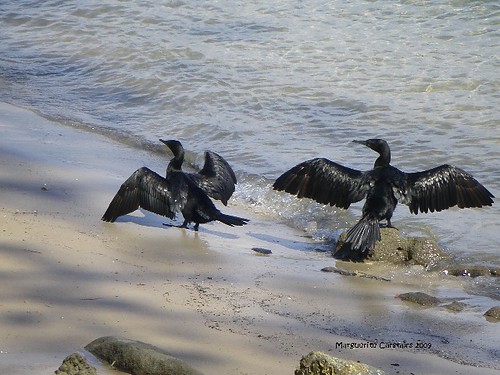Little Pied Cormorant
Phalacrocorax melanoleucos
Burrum Heads is full of cormorants.
They collect on the sand banks at low tide.
Here they have come ashore to dry their waterlogged wings.
The bird family Phalacrocoracidae is represented by some 40 species of cormorants and shags. Several different classifications of the family have been proposed recently, and the number of genera is disputed.
Kingdom: Animalia
Phylum: Chordata
Class: Aves
Subclass: Neornithes
Infraclass: Neoaves
Order: Pelecaniformes
Suborder: Sulae
Family: Phalacrocoracidae
Reichenbach, 1850
Genus: Phalacrocorax (but see text)
Brisson, 1760
There is no consistent distinction between cormorants and shags. The names "cormorant" and "shag" were originally the common names of the two species of the family found in Great Britain, Phalacrocorax carbo (now referred to by ornithologists as the Great Cormorant) and P. aristotelis (the European Shag). "Shag" refers to the bird's crest, which the British forms of the Great Cormorant lack. As other species were discovered by English-speaking sailors and explorers elsewhere in the world, some were called cormorants and some shags, depending on whether they had crests or not. Sometimes the same species is called a cormorant in one part of the world and a shag in another, e.g., the Great Cormorant is called the Black Shag in New Zealand (the birds found in Australasia have a crest that is absent in European members of the species). Van Tets (1976) proposed to divide the family into two genera and attach the name "Cormorant" to one and "Shag" to the other, but this flies in the face of common usage and has not been widely adopted.
The scientific genus name is latinized Ancient Greek, from φαλακρός (phalakros, "bald") and κόραξ (korax, "raven"). This is often thought to refer to the creamy white patch on the cheeks of adult Great Cormorants, or the ornamental white head plumes prominent in Mediterranean birds of this species, but is certainly not a unifying characteristic of cormorants.
"Cormorant" is a contraction derived from Latin corvus marinus, "sea raven". Indeed, "sea raven" or analogous terms were the usual terms for cormorants in Germanic languages until after the Middle Ages.
The French explorer André Thévet commented in 1558 that "...the beak [is] similar to that of a cormorant or other corvid," which demonstrates that the erroneous belief that the birds were related to ravens lasted at least to the 16th century.
Photographs and Art from Places on the Coast of East Australia. Gold Coast, Stradbroke Island, Burrum Heads, Hervey Bay and surrounding coastal areas
Thursday, November 12, 2009
Comorants dry their wings
Subscribe to:
Post Comments (Atom)

140x45.jpg)




No comments:
Post a Comment